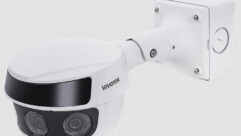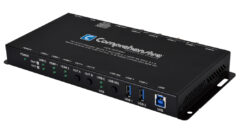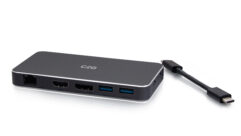A New Year of Resolutions
Jan 1, 1998 12:00 PM,
Peter H. Putman
This year promises to be exciting for the large-screen display industrywith plenty of new projectors, monitors and interfaces. The mostsignificant advances will be in display resolution, LCD and ILA imagingengines in particular. Three years ago, maximum display resolution offlat-screen technology peaked at 640 x 480. If you needed a higherresolution, you’d have selected a multiscanning CRT projector or CRT/LCDhybrid.
Today, the situation is different. LCD and ILA projectors are availablewith resolutions as high as 1,365 x 1,024. Almost 12 new 1,024 x 768portable and desktop LCD projectors are shipping (or will early this year),many of which have full connectivity for workstations andboardroom/auditorium applications. Suddenly, that secure niche that 7 inch(178 mm), 8 inch (203 mm) and 9 inch (229 mm) CRT projectors once occupieddoesn’t seem so secure.
One size fits allAdvocates for flat-screen imaging have predicted the death of traditionalCRT imaging for many years. The biggest arguments against CRT projectorshas been their complex operation and the need to converge the separate red,green and blue guns to achieve precise registration. As a result, most CRTprojectors are permanently installed because even the slightest movementtowards or away from the screen shifts the three-imaging CRTs out ofconvergence.
No such problem occurs with an LCD or DLP projector; just zoom and refocusthe lens as you move. But the appeal of flat-screen projectors isn’tlimited to a single projection lens. CRTs are hamstrung by the inability togenerate much electron beam intensity without losing resolution. Turning upbrightness expands the beam’s diameter and accelerates the aging of thecathode-ray tube.
In flat-screen projectors, the resolution is determined by the number andsize of pixels. If an application requires more lumens, select a brighterprojector with powerful lamp. Many projectors have a lens-shift feature tocorrect for keystone distortion, and almost all can be used in front-,rear-, and ceiling-mount modes.
Despite these advantages, VGA and SVGA LCD/DLP projectors have not beenserious contenders for more critical high-resolution applications. Softwaresignal processing gimmicks to allow the display of higher resolution imageson a lower-resolution display (such as pixel mapping and scaling) come upshort of the results obtained with a correctly adjusted multiscanning CRTprojector.
Storming the castleThere are signs that the status quo is changing. Hughes-JVC leads theattack with two single-lens projectors. The first, the Model 100, is a 150pound (67.5 kg) CRT/ILA hybrid with maximum resolution of 2,000 x 1,500lines, and the second, the DLA-G10, is a desktop box weighing less than 30pounds (13.5 kg) and sporting a native resolution of 1,365 x 1,024. Bothemploy a single lens system and produce 1,500 and 1,000 ANSI lumens,respectively.
A second offensive strike is coming from Electrohome, who announced a newflat-screen projector based on IBM Japan’s reflective LCD technology. TheDLV-1280 has a native resolution of 1,280 x 1,024, uses a single lens andxenon lamp and is also intended for tabletop and fixed installations.
Also, several 1,024 x 768 LCD projectors have been launched or announced.Several models have a full range of component RGB connections and are aimedsquarely at customers who had previously used CRT projectors. Others havealso shown production models and prototypes of 1,280 x 1,024 LCD projectors.
Have CRT projectors met their match? A convincing argument could be madealong those lines, especially with the availability of higher resolutionimaging devices, but there are still some caveats.
Give and takeRegardless of the technology, any flat-screen display does best when theincoming signal matches available pixels one-for-one. If a lower-resolutionimage is connected, fewer available pixels will be turned on, and the imagewill appear smaller. Connect a higher-resolution signal, and a portion ofthe image will be cropped out. The only way to deal with these two problemsis to re-map and re-size incoming signals electronically to make sure everyavailable pixel is used.
It’s a tricky process that often falls short of expectations when smalltext and fine lines of image detail are involved. Images that are re-scaledup in size often acquire a few digital artifacts, such as pixelization andaliasing of curves. This is common when zooming up video on LCD projectors.
Going the other way is trickier because the manufacturer is trying tocompress higher-resolution images into a smaller space. If type sizes andfonts are bold and large enough, image compression can work well.Unfortunately, users working with 1,024 x 768 and higher resolution imagesoften have quite a bit of fine text and lines, many of which will fallthrough the cracks when compressed.
CRT projectors have no such limitation. They are merely readjusted to syncup to the appropriate horizontal and vertical rates, and the picturegeometry is tweaked to produce the correct picture dimensions. Whethervideo, SXGA or Powerpoint graphics, the signal source is essentiallyirrelevant to a CRT projector as long as it falls within the sync range.
That combination of bright images and a single zoom lens looks appealing tothe end user, who may be willing to live with the limitations offlat-screen scaling and remapping to save money and execute a less complexinstallation. For fussier customers, the conventional image light amplifiermight be a strong alternative, offering variable resolution up to 2,000lines, high light output, a single zoom lens, and no convergence needed.
What’s aheadFlat-screen projectors will continue to gain market share at the expense ofCRT projectors, especially with their combination of price, performance,size and connectivity. Their allies in this battle,-image scalers, arerelatively new, but they are improving and will probably replace scanconverters and line multipliers within the next three to five years.
The prediction is that it will take a flat-screen projector with a nativeresolution of at least 1,600 x 1,200 lines, multiple zoom and prime lensoptions, conference-room connectivity, top-notch image scaling, and 500 to2,000 ANSI lumens of light output to break down the door to the CRT castle.Now, only Hughes-JVC and Ampro offer such a product, but you’ll see a dozenor more by INFOCOMM 2000.










